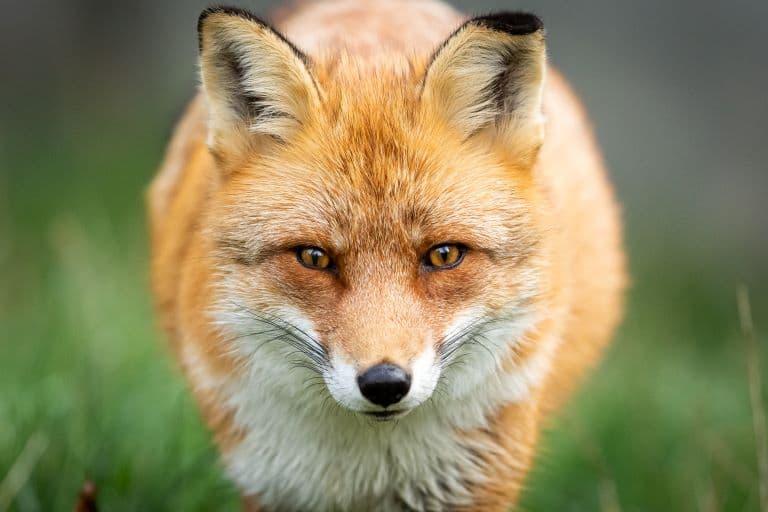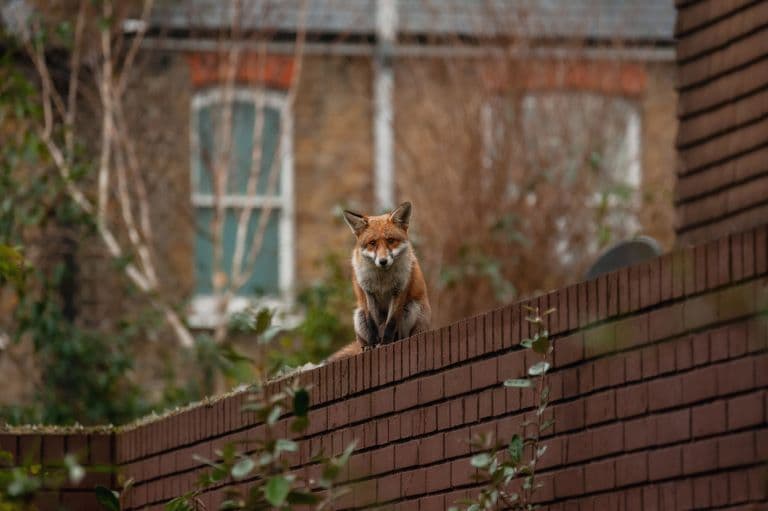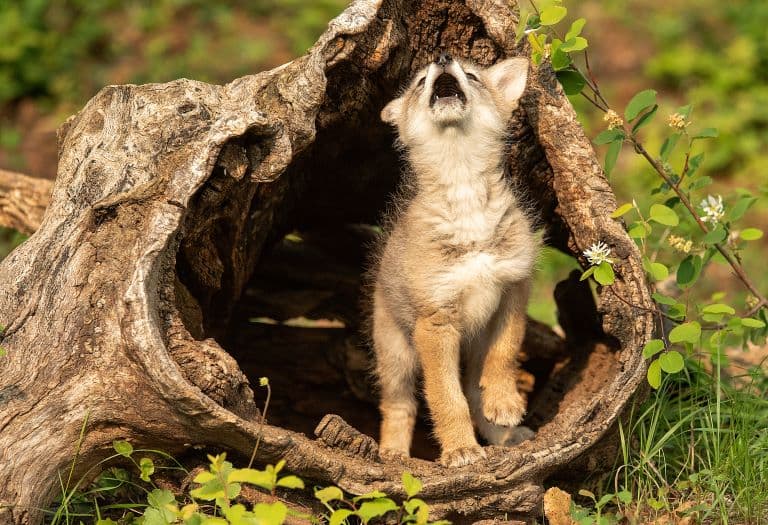Red Fox Profile
If you were a small, lightweight predator of chickens; adapted to cool climates with few-to-no natural predators you’d have to be crazy to think of invading the boiling, hostile fauna of Australia would be a good idea.
You’d have to be just as crazy to think North America would be any more forgiving; with its coyotes, wolves, gun-wielding humans and eagles.
Crazy like a red fox!

Red Fox Facts Overview
| Habitat: | Forest, shrubland, grassland, wetlands, desert, urban, tundra |
| Location: | Widespread across Eurasia, North America, North Africa, Australia |
| Lifespan: | Average of around 3-7 years, max 15 years |
| Size: | Up to 1.5 meters (5 ft) long, including tail |
| Weight: | Up to 14kg |
| Colour: | Reddish brown |
| Diet: | Omnivorous, most smaller animals, also fruit |
| Predators: | Humans, coyotes, wolves, mustelids, eagles, bears, mountain lions |
| Top Speed: | 48 km/h (30 mph) |
| No. of Species: | 1 |
| Conservation Status: | Least Concern (IUCN) |
Red foxes are one of the most successful mammals on the planet. They are the complete package: the social smarts and adaptable diet of a dog with the speed and lethal agility of a cat.
They can tolerate extreme temperatures in both directions, adjust to human development, and get in and out of your chicken coop before you’ve managed to unlock the gun compartment.
This makes them a force to be reckoned with in ecosystems that haven’t evolved to handle the species, but in their natural habitats, they’re one of the few animals that seem to be doing better as a result of human-caused habitat conversion.
Interesting Red Fox Facts
1. Catlike dogs
Red foxes are the largest of the 12 foxes in the Vulpes genus, and are certainly Canids by all taxonomic definitions, though they have some very catlike adaptations.
Being small for their family, they eat much smaller animals than many, so they have teeth that are a lot thinner and sharper like a cat.
Their whiskers are also proportionally longer than is commonly associated with dogs. They kill their prey similarly to cats, with high-pressure bites onto the skull or spine, unlike dogs who shake and tear their prey.
Their agility is certainly cat-like, and their speed keeps them ahead of dogs in a chase (only their stamina isn’t as good).
They are said to be able to leap 2 meters high, but at the same time, they communicate and have the high social intelligence that the family is renowned for. 1
2. They’re incredibly adaptable
This mixture of traits has served foxes well, and the Red fox is the most successful of all. They’re one of the most widespread of all mammals, spanning a native range across Eurasia, and an introduced range across North America and Australia.
They span up to the Arctic and down to North Africa and Central America, from sea level to 4,400 meters closer to the sun. They are comfortable in the tundra, forests, prairie, desert, mountains and, notoriously, farmland.
But they’re most commonly spotted in cities. 2 3
3. They thrive in cities
Cities bring a lot of advantages to a clever and adaptable animal. There are empty offices at night, the grounds of which are perfect for undisturbed dens. There is a lack of wildlife in general, including potential predators, but there are a lot of rats and pigeons. There is also a lot of discarded food, a decent network of roads and alleys to follow, and plenty of waterfowl in the local parks.
Foxes are rarely a pest in the city, too, which doesn’t make them a target for humans, so all in all, the city provides much of what the fox needs and a lot less of the struggles it would find in the wilder areas.
City foxes adapt to urban life by changing their diets. The closer to the city centre they live, the fewer earthworms and insects are found in their meals. Instead, they have an increased number of pizza slices, fast food remnants, and other city waste.
The food supply in the city also changes less in quality throughout the year, whereas seasonal shifts in availability are obvious in rural fox populations.
Foxes examined in the city show healthy weights and good body conditions, showing that this is a pretty good life for the fox.

4. They’re highly communicative
One of the strongest attributes to the success of this species is their social abilities. Fox’s communication is complex and uses a mix of verbal and non-verbal components.
Foxes are known to have facial expressions, and not only in Wes Anderson movies. Their faces also secrete various communicative smells, as do their anal glands (which will be a familiar fragrance to anyone living in a fox city). They have glands around their jaws and lips, the soles of their feet…
Foxes are very smelly animals.
But they also talk a lot. There are at least 28 vocalizations in the red fox repertoire, used to communicate both at close range and long distance. Young foxes are particularly vocal and grow up chattering to one another quite enthusiastically.
Ear and tail position, as well as body posture also play a role in fox communication, but the recognisable bark of the vixen is probably the most familiar of all communications as it sounds a bit like a discontented ghost and has frightened many countryfolk on their first night in the city. 4

5. They’re ecologically important
It’s no surprise that an animal this widespread and successful is important to its ecosystem. Foxes create immense selective pressures across their range and help with population control of animals smaller than the preferred prey of the larger carnivores like wolves and coyotes.
This is also what makes them so incredibly dangerous in habitats where they are at risk of becoming invasive. A red fox would be the worst nightmare of the already struggling bird populations in New Zealand.
6. They’re invasive in a large part of their range
Like most introduced animals to island habitats, the arrival of foxes in Australia didn’t go as well as it could have for the native fauna.
Agricultural production was also affected, and now the country is at the point of needing to reintroduce its old wildlife to areas where the fox had wiped out entire species. Foxes are big enough to take a newborn lamb, which they happily do to the frustration of the farmers (and the mother, probably), and so made their way through both wild and domestic animals all across the country.
They now cover 75% of the island, having followed the invasive rabbits to all nooks and crannies. And, just as with the rabbits, toxins are now employed to keep them from destroying everything before it’s too late. 5
7. They have a lot of competition
But it’s not entirely plain sailing for the species, even in invasive contexts. In North America, there are a lot more predators left to interfere with the foxes’ plans.
While the species does have some natural predators, many more animals will kill them out of competitive drives, and fox cubs are particularly susceptible to this.
Cubs can be killed by animals as small as weasels and stoats, or as big as wolves or even bears. Again, this is a factor that drives some populations to the safety of the urban environment.
Red Fox Fact-File Summary
Scientific Classification
| Kingdom: | Animalia |
| Phylum: | Chordata |
| Class: | Mammalia |
| Order: | Carnivora |
| Family: | Canidae |
| Genus: | Vulpes |
| Species: | Vulpes |
Fact Sources & References
- Ki Steiner (2010), “What the Fox ACTUALLY Says (The Scream of a Fox)”, YouTube.
- STEPHEN HARRIS (1981), “The food of suburban foxes (Vulpes vulpes), with special reference to London”, Wiley Online Library.
- “Vulpes vulpes red fox”, Animal Diversity Web.
- UK Wildlife Cam (2019), “Rural vixen female fox screaming – with sounds”, YouTube.
- “Red fox”, Agriculture Victoria.
